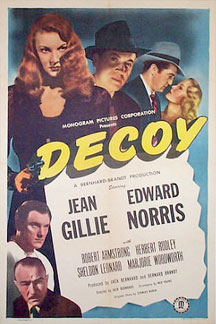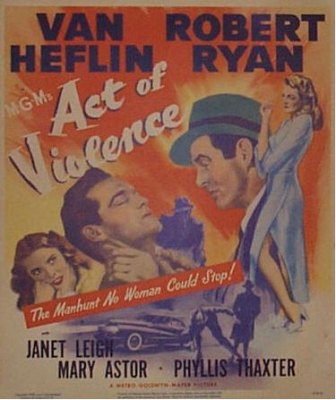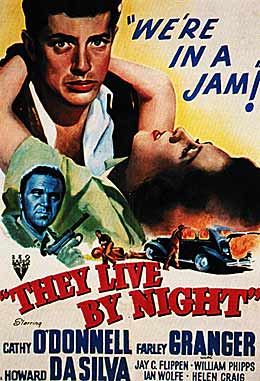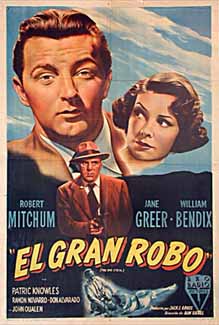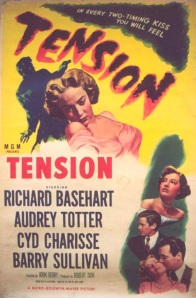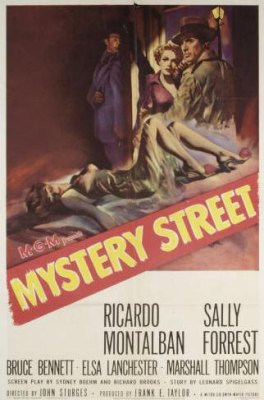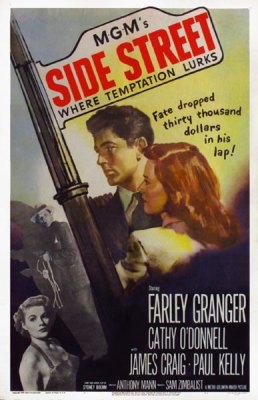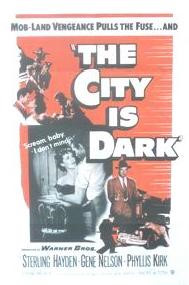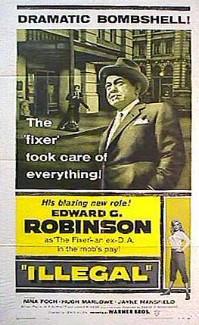| Reviews & Columns |
|
Reviews DVD TV on DVD Blu-ray 4K UHD International DVDs In Theaters Reviews by Studio Video Games Features Collector Series DVDs Easter Egg Database Interviews DVD Talk Radio Feature Articles Columns Anime Talk DVD Savant Horror DVDs The M.O.D. Squad Art House HD Talk Silent DVD
|
DVD Talk Forum |
|
|
| Resources |
|
DVD Price Search Customer Service #'s RCE Info Links |
|
Columns
|
|
|
Film Noir Classic Collection, Vol. 4
In recent years Decoy has acquired the same sort of hip cult status as Edgar Ulmer's not-dissimilar Detour (1945) achieved more than 30 years ago. Both are cheap indies produced for release through Poverty Row: Detour was distributed by lowly PRC, Decoy the product of the marginally superior Monogram. Deliriously nasty and over-the-top, it's as much a product of cheap pulp fiction and True Crime exploitation as noir, though much of the genre's classic iconography is on overdrive here. Like several films in this set, Decoy opens with a bang, literally and figuratively, an intriguing "What's-Going-On-Here?" prologue, with a mysterious man (Herbert Rudley) for reasons unknown hitching a ride several hundred miles with a zombie-like determination. In cold blood he shoots a woman, Margot Shelby (Jean Gille), who in a flashback-driven confession to cop Joe Portugal (Sheldon Leonard) reveals herself to be the most gleefully sadistic dame in all of film noir.
Turns out the man was a small-time doctor, coaxed and coddled and played for a sap by Margot to use his drugs and medical skill to resurrect another man she's likewise jerking along, convicted murderer Frank Olins (King Kong's Robert Armstrong), immediately after his execution so that he can lead her to his fortune in buried loot.
For the most part Decoy earns its reputation as one of the great noir discoveries. Though shot on the cheap for probably less than $50,000 and no more than a week's shoot, it crackles with an audacious, unrepentant sleaziness rare in '40s Hollywood, with several extraordinary moments that will leave viewers aghast and nonplussed. Its cheapness drags down its middle section considerably, however, with long, static medium shots that frequently begin with empty rooms: characters slowly wander in, deliver their lines with little in the way of imaginative blocking, and leave. In this sense Decoy never entirely overcomes its low budget and brief shooting schedule, though its qualities more than compensate for its shortcomings.
The many surprises come in all shapes and sizes. Olins being brought back from the dead (qualifying this as science fiction, as well as noir) is made believable thanks to Armstrong's surprisingly good performance. Newly revived, his backstreet Lazarus is overcome with emotion and, initially at least, can barely cope with the notion of having been reborn. Decoy is likewise peppered with eccentric types, like the two Mutt and Jeff morgue workers where Olins body is brought after expiring in the gas chamber.
Most of the film's reputation, this despite the fine playing by Rudley, rests on the hysterical performance of British-born Jean Gillie, then married to the film's American director, Jack Bernhard. It's not exactly a great performance, more one of high camp, but Gillie (who died soon after this was made) undeniably gives it her all, one of unrepentant depravity.
Like Decoy, Act of Violence starts out as a mystery, foregoing the usual opening titles (quite unusual at the time) to instead follow pistol-packing Joe Parkson (Robert Ryan, very good) as he hops aboard a Greyhound bus in New York and makes a beeline to a (fictional) burgeoning suburb somewhere outside Los Angeles. He's looking for Frank Enley (Van Heflin) who, as it turns out, has gone fishing for the weekend. Determined for reasons still unclear to shoot Enley in cold blood, Parkson follows his tracks to the mountains, even renting a rowboat hoping to kill him then and there. When Enley, a pillar of his suburban community, eventually catches on that Parkson is after him, he high-tails it back home hoping that by drawing all the shades and turning out all the lights his former air force buddy will simply give up and go away.
But Parkson's resentment at Enley's celebrated veteran status runs deep, and without exactly revealing anything, Act of Violence is most interesting in the way it exposes the dark contrasting undercurrent of postwar veterans living the American Dream in their shiny new tract homes yet haunted by recent nightmares of war (and their own actions) that aren't so easily extinguished. (Mild Spoilers) Moreover, it intriguingly blurs the lines between hero and antagonist, with Parkson exposing Enley's Dark Secret - one that in 1948 especially must have elicited a disgusted reaction from movie audiences. Even better, as the film gets darker and darker with Enley, trying to lose Parkson, hiding out with an aging prostitute (The Maltese Falcon's Mary Astor in a wonderfully natural, world-weary performance), Enley's behavior subtly slips back into that of a moral weakling. All this, in turn, makes Parkson much more sympathetic, though his barely contained rage (Ryan was especially masterly at expressing this) remains unnerving.
Though its ending is too pat and certain motivations and reactions underdeveloped, Heflin and especially Ryan are excellent, as is Mary Astor, and actors' director Fred Zinnemann surely deserves a big part of the credit. (The old adage rings true here: when some of the performances are good you can credit the actors, when all of the performances are good, the director is usually responsible.) Twenty-one-year-old Janet Leigh and Phyllis Thaxter are likewise fine playing paralleling counterweights as Enley's wife and Parkson's girl, both frantically trying to understand their respective man's irrational behavior. As with the later Crime Wave, Act of Violence makes great use of downtown Los Angeles noir staples, including Angels Flight and several blocks of Skid Row locales.*
The Live By Night was Nicholas Ray's directorial debut, which he also adapted from Edward Anderson's Thieves Like Us, later remade into the excellent, same-named Robert Altman film of 1974. Cathy O'Donnell and Farley Granger are doomed lovers in a lofty work that somewhat anticipates many of the themes in Ray's later Rebel without a Cause (1955), with Granger the youngest of a trio of men that break out of prison. Granger's Arthur "Bowie" Bowers has already wasted most of his life in prison, since childhood in fact, so his romance with uneducated and poor Catherine "Keechie" Mobley, the niece of one of the other convicts (Jay C. Flippen) has an especially poignant innocence - he's barely interacted with other women before this.
In contrast to Flippen's would-be criminal mastermind and Howard Da Silva's hardened one-eyed alcoholic, Bowie is basically a sensitive, ordinary youth in which circumstances beyond his control earn him and his new girlfriend a Bonnie & Clyde-like infamy, and most of the film follows them on the run, trying to eke out a life others their own age optimistically look forward to. They get married and find a little cottage to set up housekeeping in, but Flippen's schemes and Da Silva's boozing and gambling keep pulling him back into a life of crime.
The picture is a paradox of overemphatic Hollywood romantic melodrama contrasting a deliberate, sometimes overstated effort to break away from the standard Hollywood crime thriller. There's a lot of attention-grabbing aerial shots (most sources credit a helicopter but I wonder; the images are so smooth they look more like something taken from an airplane) that underscore the couple's shark-like, constantly-moving flight from justice, and an innovatively shot car wreck that's more in the style of Orson Welles than your typical RKO movie. Even better, there's an attention to the authentic details of Depression-era rural folk. With a cast fresh or unfamiliar to audiences at the time, everyone is quite believable, especially O'Donnell, whose unusual yet childlike, almost angelic features (no wonder William Wyler cast her as Tirzah in Ben-Hur) is emphasized even further by the absence of Hollywood glamour makeup. She's great.
Another terrific, easy-to-miss performance is Helen Craig's Mattie Mansfield, the embittered wife of another con whose parole keeps getting denied. Looking a lot like Eileen Brennan in The Last Picture Show and one of several direct influences on Arthur Penn's Bonnie and Clyde, Craig's Mattie is positively dripping with poverty-driven despair.
The slightly self-conscious Romeo & Juliet-like tragedy of They Live By Night gives way to innocuous comedy and the mildest of suspense in The Big Steal, a troubled RKO production filmed extensively on location in Mexico by director Don Siegel. Out of the Past's Robert Mitchum and Jane Greer were re-teamed almost by default, only here Greer is a relatively benign character, an assertive woman looking to get back money cheated out of her by slimy ex-boyfriend Jim Fiske (Patric Knowles). He's racing across Mexico to deliver some stolen army payroll, so she teams up with Lt. Duke Halliday (Mitchum) who's been framed for the crime. Meanwhile, Halliday's superior, Capt. Blake (William Bendix) is hot on their trail, while Mexican Inspector General Ortega (former silent leading man Ramon Navarro) is keeping tabs on the various cats and mice.
As Jewell details in the film's audio commentary track, the film was subject to the tinkering of new studio head Howard Hughes, myriad alternations from its violent script at the hands of the Production Code and, more directly, was severely disrupted by Mitchum's arrest on a marijuana possession charge, for which he eventually served time in the middle of production. All this resulted in the film's screenplay being retooled to the point where all logic goes out the window. In particular, Bendix's character and his actions make no sense at all and come off as a major cheat near the end.
What's left is pretty much a star-driven potboiler with, for the time, unusual and extensive location photography. Mostly though the picture leans heavily on Mitchum's tough guy charm.
Far superior to The Big Steal in every way, the vastly underrated Where Danger Lives offers Mitchum a far more interesting script, one that's consistently inventive and genuinely surprising. Jeff Cameron (Mitchum) an emergency room doctor who, despite already dating a nurse (Maureen O'Sullivan, then director John Farrow's wife), falls under the spell of a suicidal patient, Margo Lannington (Howard Hughes protégée Faith Domergue). He's crazy about her, but she insists her wealthy, acerbically domineering father (Claude Rains, in a magnificently subtle performance) will never consent to their getting married. Nevertheless, Jeff decides to confront him - only to learn to his considerable surprise that Margo hasn't exactly been honest with him.
To say more would cheat first-time viewers, except to say that most of Where Danger Lives finds Jeff and Margo on the run, certain the police are after them. Or are they? Another of the film's many surprises is its point-of-view, realistically sticking with the couple (as well as from Jeff's individual perspective) and their vantage point. They make wrong assumptions while Jeff's judgment is further hampered by a head injury that keeps his senses off-kilter even further. **
Some have argued that Mitchum isn't a particularly convincing physician, nor does the writing make his instant passion toward Margo any more plausible than it sounds, and that his characterization is too inconsistent. I'd argue that at the beginning of the film Mitchum's Jeff knows all too well he's diving head-first into danger, and that his subsequent actions are logically explained and even dramatically enhanced by that brain injury, one that also allows for the picture's dream-like machinations.
As for Domergue, whose looks coupled Ava Gardner's dark beauty with a fawn-like innocence (enhanced by those pouty lips and big, slightly wall-eyed dark eyes) well, no, she wasn't much of an actress - she even had a rather pronounced lisp - but the film uses her limited range perhaps better than anything else she ever did, certainly more so than her later equally famous (for other reasons) sci-fi films: This Island Earth, It Came from Beneath the Sea, etc.
Noir veterans Richard Basehart and Audrey Totter are in top form in Tension, a well-made if not especially memorable noir, with Basehart the antithesis of his He Walked By Night cop-killer role as Warren Quimby, a milquetoast drugstore manager and long-suffering husband to a greedy and coarse wayward wife, Claire (Totter), who all but flaunts her infidelity. She beds down with men in their apartment nearby for gifts Quimby's can't afford, while he has kittens trying to manage his drugstore (this was back in the day when such shops had lunch counters) while Claire openly flirts with the customers.
When she decides to leave him for Barney Deager (Lloyd Gough), a barrel-chested salesman with a beachfront home, he comes up with a plan to murder this arrogant wife-stealer: Quimby will invent another identity, "Paul Sothern," and in this guise establish himself in a Westwood apartment building and badger Deager with threatening phone calls, so that once Barney is dead the police will go looking for "Paul Sothern" and never even suspect him.
But as things must in noir, Quimby's scheme quickly begins to unravel, especially after in his new identity Quimby himself falls for kindly new neighbor Mary Chandler (Cyd Charisse) and Barry Sullivan's Columbo-like manipulative detective is assigned the case.
Basehart delivers fine work as both fidgety Quimby and his liberating alter-ego, admirably contrasting them in subtle, not obvious ways. (Physically, Quimby's transformation involves the use of early contact lenses - thick heavy looking pieces of plastic that must have been brutal on the eyes.) Totter's bad girl is like a bitch in heat, ignited by the sight of a twenty-dollar bill.
Another unexpected treat, Mystery Street is a proto-CSI type police procedural, with top-billed Ricardo Montalban first trying to identify the skeletal remains of a murder victim, then build a case against her murderer. The picture's unusual but highly effective cast, direction by rising talent John Sturges, cinematography by genre master John Alton, and realistic, often grisly and unsentimental approach make this one really intriguing from start to finish.
The opening act follows the (at this point) unexplained activities of "B girl" Vivian Heldon (Jan Sterling), as she tries to meet with one of her "clients" out on Cape Cod. Needing transportation from Boston, she meets a young man, Henry Shanway (Marshall Thompson), who is too drunk and despondent over the sudden death of his wife's baby to notice that she all but bludgeons her way into his life, she driving his car like a bat out of hell to the middle of nowhere. When he finally starts to sober up, she simply steals his yellow Ford, leaving him stranded. Later, near the beach, she's shot dead at point-blank range and buried in the sand.
Some time later, after the tides and the sand have picked Vivian's body clean, her skeletal remains are found, leaving Detective Lt. Peter Morales (Montalban) little to go on, except seek the assistance of a Harvard Medical School forensics expert Dr. McAdoo (Bruce Bennett).
What keeps Mystery Street so engaging is its procedural and medical verisimilitude, fine character vignettes, and a willingness to allow Montalban's character to make very reasonable but incorrect assumptions, with Morales persuaded by incomplete scientific evidence that Shanway must be the murderer, though it's clear to the audience from the beginning he's not. One wonders if Montalban, a fine actor but never quite the established leading man, won the role because bigger stars turned it down on the basis that the detective is at times unsympathetic and wrongheaded if sincere in his desire to nab the murderer.
(Major Spoilers I only sampled the DVD's audio commentary, but I also wonder if a much darker ending was originally envisioned. Shanway's character escapes from prison and is never seen again, with the hard-to-swallow reassurance that he'll soon be happily reunited with his understandably worried wife. The way the end is pieced together, it seems quite possible that, as perhaps originally conceived, Shanway might have been killed trying to elude police.)
Only during the Dore Schary years could MGM have produced a film as grimly clinical as this. Vivian's murder is brutal enough, but it's unnerving to imagine Jan Sterling transformed into a pile of bones in a cardboard box, that "extra" little bones found at the scene reveal that she was three months pregnant. Or, in the film's most haunting image, how Vivian's identity is finally established by layering transparencies of an old black and white photo of her while she was alive with another slide of the victim's skull, where creepily they match up. (Could Hitchcock have remembered this when he conceived Psycho's final shot, an almost subliminal double exposure of a grinning Anthony Perkins, overlaid with a skull?)
Fine performances abound, most notably Elsa Lanchester's typically eccentric turn as a boozy landlady, an amoral spinster who blithely sells Vivian's belongings after she goes missing, and who unwisely tries to blackmail the real murderer, underestimating if not quite oblivious to the peril she's putting herself into. Marshall Thompson, later the star of several low-budget but cult sci-fi pictures, makes his character's foolish behavior believably motivated (unlike Side Street's hero; see below), while Betsy Blair is excellent as a streetwise tenant in Lanchester's building. Montalban and Bennett are quite good, too, their characters neatly and subtly contrasting one another in myriad ways.
Apparently filmed just prior to Mystery Street the somewhat similar but vastly inferior Side Street is like a noir "greatest hits," a big muscle MGM showpiece that reunites They Live By Night's Farley Granger and Cathy O'Donnell, teaming them with director Anthony Mann, whose noirs before - this T-Men, Raw Deal, He Walked By Night - were cheaper productions, made for Eagle-Lion, but overall much better than this.
The picture gets off to a great start, with haunting aerial shots of Manhattan's brick and mortar landscape that anticipate West Side Story a decade later, which is then followed by an interesting montage reaching deep into the milieu of everyday New Yorker life. Like the rest of the film, this magnificently photographed sequence is undermined some pointlessly redundant narration.
The cluttered story follows down-on-his-luck war veteran Joe Norson (Granger), whose failed business has forced him and pregnant wife Ellen (O'Donnell) to move back in with his parents, while she has to deliver her baby in a charity ward. Finding work as a mailman, he decides to steal a couple of hundred bucks from an office, but once the deed is done realizes he's actually pinched thirty grand in blackmail money, though he doesn't realize the money is dirty.
He tries to return it, but the criminals (James Craig and Edmon Ryan), who have already murdered coconspirator Lucille (Adele Jurgens), think Joe might be a cop, and are cautious about retrieving it. Meanwhile, a bartender entrusted with Joe's loot himself steals the dough and makes himself scarce, so that when the blackmailers come looking for Joe, he's no longer got the money.
Neither fish nor fowl, Side Street, is all over the map. Attempts to recreate the intimacy of Granger and O'Donnell's scenes in They Live By Night don't work because the writing is too melodramatic, even syrupy, and because Granger's performance just isn't up to par and his character irredeemably foolish. (Spoliers) The film's wrap-up is a real cheat, with the narrator assuring audiences that Joe's "going to be all right." Really? When you consider the preponderance of incriminating evidence heaped upon him by the final reel, one can only wonder how luckless Joe is going to wind up with anything short of a trip to the electric chair.
There's an attempt as some of the same kind of police procedural aspects in this as in the subsequent Mystery Street, but where that film's investigation rings true and authentic, Paul Kelly's cop and the work of his men (including Charles McGraw) is strictly by the numbers.
On the plus side, though, is Mann and cinematographer Joseph Ruttenberg's (Gaslight, Somebody Up There Likes Me) terrific and unusual use of Lower Manhattan's topography, which turns New York into a maze of valleys and crevices, stifling and claustrophobic.
Crime Wave is very nearly a perfect B-movie. A fast-paced 73-minutes, it crackles along with an edgy tension buttressed by strong characterizations while making superb use of real Los Angeles exteriors and, in large measures, interiors. After a cop is murdered in a botched gas station robbery, three escaped convicts (Ted de Corsia, Charles Bronson, and Decoy screenwriter Nedrick Young)*** eventually demand refuge at the home of ex-con Steve Lacey (former dancer Gene Nelson), a man trying to put his life back in order with the help of his supportive wife, Ellen (Phyllis Kirk). Steve wants nothing to do with his former cellmates, but they put the bite on him anyway, even insisting that he helps out in their grandiose, certain-to-fail plans to rob a Glendale bank.
Further adding pressure is Detective Lieutenant Sims (Sterling Hayden), a toothpick-chewing, super hard-boiled cop who seems to have nothing but contempt and utter distrust for ex-cons like Steve. No matter that the escapees barged their way into Steve's home; Sims has no doubt Steve invited them with open arms.
Superbly directed by Andre de Toth with much visual flair and unfolding in something approaching real time, Crime Wave makes especially great use of Los Angeles' underbelly, particularly in the neighborhoods around Chinatown and what is now Skid Row, as well as the immediately recognizable Brand Boulevard part of downtown Glendale and Atwater Village area just south of that. In the end, Crime Wave's unpretentiousness and attention to characterization and storytelling makes it one of the best noirs ever.
Entertaining if somewhat ridiculous and arguably not at all noir, Illegal's main asset is its leading player, the irreplaceable Edward G. Robinson, then pretty much at the end of his starring career after being gray-listed for his liberal-leaning predilections; soon after this, however, he became a respected and popular character star. In Illegal, Robinson is Victor Scott, a famous Los Angeles District Attorney with political ambitions, all of which come shattering down when it's discovered (seconds too late, of course) that he's sent a man (DeForest Kelley) to the electric chair for a crime he didn't commit.
Initially despondent, Scott eventually finds a new calling as a flashy defense attorney (sort of a cross between Johnnie Cochran and Horace Rumpole), but his courtroom theatrics and high batting average soon attract the attentions of mobster Frank Garland (Albert Dekker) who pressures Scott to join the fold. Later (spoilers), when Garland's D.A. office insider (Hugh Marlowe) is killed - and Scott's protégée and almost-girlfriend, Ellen (Nina Foch, cast against type) is charged with murder - Scott rushes to her defense.
Of course, when you stop and think about it, this dizzying arrangement strains all credibility: the former D.A. defends his former assistant, charged with murdering their mutual colleague, and are up against the new district attorney (Edward Platt), Ellen's current boss.
All this amounts to courtroom drama that plays like a lesser episode of Perry Mason but Robinson's performance, as it almost always was, is so compelling that it hardly matters, especially given his character's roller-coaster character arc and Scott's courtroom tricks - which include swallowing poison in an especially outrageous bluff.
Video & Audio
Though one might reasonably have assumed that the Warner Bros. and MGM titles would hold up better than the RKOs and the Monogram one, all ten films look Very Good to Exceptional, with Monogram's Decoy being the biggest delight, considering how dire most of that studio's titles have fared in indie and public domain releases. The RKO library has been frustratingly inconsistent in terms of available elements, but the titles presented here look just fine. The transfers serve the films' often exceptional photography very well, especially considering the genre preponderance of dimly and starkly-lit street scenes and interiors. All are full frame with the exception of Illegal which is 16:9 enhanced here to 1.77:1 and looks great. Crime Wave seems to have been shot standard ratio but exhibited in some markets cropped, probably to about 1.66:1, at least based on the opening titles. In any case, Warner Home Video's team made the right choice releasing it full frame, as Andre de Toth's compositions often use every square millimeter of the frame.
The Dolby Digital mono audio is fine throughout. The main features include optional French subtitles, but that's it. There are two movies on each of the five single-sided, dual-layered discs, packed in standard DVD cases.
Extra Features
Each film includes an audio commentary and a new mini-featurette, full-frame, each running about five minutes. The commentaries, by Drew Casper (Act of Violence), Alain Silver and Elizabeth Ward (Mystery Street and Tension), James Ellroy and Eddie Muller (Crime Wave), Stanley [not Stabley!] Rubin and DVD Talk's Glenn Erickson (Decoy), Nina Foch and Patricia King Hanson (Illegal), Rick Jewell (The Big Steal), Farley Granger and Eddie Muller (They Live By Night), Richard Schickel (Side Street), and Alain Silver and James Ursini (Where Danger Lives), are variable, though in fairness this reviewer only listened to a couple all the way through and sampled the others. There's a mix of writer's and actor's memories, literary, genre, and other film theory readings, trivia-packed commentaries laced with production histories - you name it. To each his own, I guess. Your tastes will draw you to some while others will leave you cold. A few of the commentaries are a bit too casual with an off-the-cuff approach that leave gaping holes of silence or too often simply convey what's happening onscreen.
Similarly, the Cliff Notes-like featurettes are okay at summing up each film's place in noir history, but those already familiar with the genre will find them slickly-made but short on substance. Most of the audio commentators appear in these segments, along with filmmakers like Oliver Stone and a few archived interviews with Audrey Totter, John Alton and the like.
Trailers for all but Decoy and They Live By Night are included, along with a segment from Warner Bros.'s infomercial-like Behind the Cameras, highlighting Illegal.
Parting Thoughts
The titles included in Classic Film Noir Volume 4 may be less familiar than those in earlier volumes, but they're just as good, with more than a few even superior to some the genre's overrated mainstays. This is a terrific set, one of the best so far of 2007, and a DVD Talk Collector Series title.
** Stephen Bowie helpfully points out that a 1965 episode of The Fugitive, "The Good Guys and the Bad Guys," shamelessly steals Where Danger Lives' plot whole cloth, in particular the sequence where the runaway couple find themselves trapped in a small town of merry-makers who demand they marry there and then. *** A young Timothy Carey turns up near the end as another member of de Corsia's gang and immediately establishes his reputation for way, way-out-there characterizations. Film historian Stuart Galbraith IV's most recent essays appear in Criterion's new three-disc Seven Samurai DVD and BCI Eclipse's The Quiet Duel. His audio commentary for Invasion of Astro Monster is due out in June.
|
| Popular Reviews |
| Sponsored Links |
|
|
| Sponsored Links |
|
|
| Release List | Reviews | Shop | Newsletter | Forum | DVD Giveaways | Blu-Ray | Advertise |
|
Copyright 2024 DVDTalk.com All Rights Reserved. Legal Info, Privacy Policy, Terms of Use,
Manage Preferences,
Your Privacy Choices | |||||||









